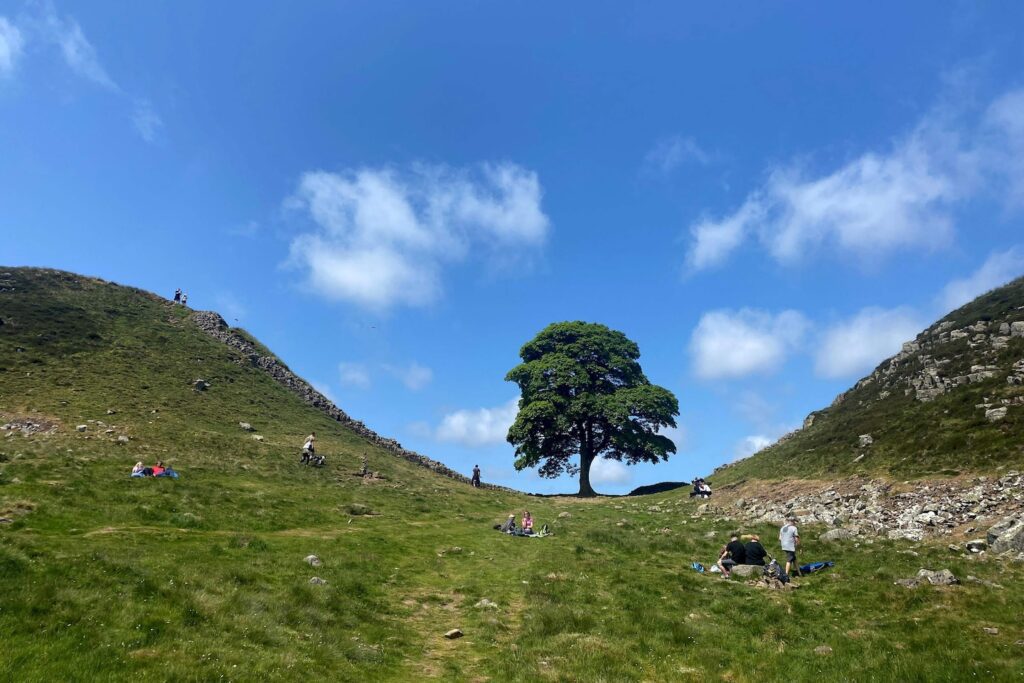He’ll never get the chance. A week and a half before his scheduled visit, a vandal cut down the tree, which sat at the bottom of a dip in Hadrian’s Wall, a 73-mile rock wall that once marked the Roman Empire’s northernmost border of Brittania.
But all is not lost. Although a stump now pokes out where the imposing sycamore once dominated the undulating English moors, arboreal experts say the tree is very much alive and will probably regrow. That process, however, will take decades, if not centuries, and the end result may look much different from the tree that charmed poets, bewitched lovers and inspired photographers.
It took more than a century for that sycamore to grow into one of the most photographed trees in England, and then only minutes for it to be cut down Wednesday night or Thursday morning. Two people have since been arrested, accused of committing what Northumbria police described as “a deliberate act of vandalism.” Authorities have not offered a motive for an alleged crime that has baffled and devastated those in the United Kingdom and beyond as they’ve simultaneously celebrated the tree’s role in their lives and mourned its sudden destruction.
“People have had their ashes scattered there. People have proposed there. I’ve picnicked there with my wife and kids,” North of Tyne Mayor Jamie Driscoll said in a social media post that has been viewed 2.2 million times. “It’s part of our collective soul.”
Chapman, a 27-year-old van mechanic from Newcastle, felt that loss Friday morning. While surfing his Facebook feed in bed, he saw word that the tree he planned to visit about a week later had been felled. He initially thought someone was trying to be funny but soon learned that it wasn’t a joke, news that hit him hard.
“It was just pure devastation,” he said.
Chapman decided to do something about it. He drove his work van to Little Ollie’s Garden Centre in Newburn, where he bought a sycamore sapling, then he drove another half-hour to get as close as possible to the Sycamore Gap site.
From there, he made the half-hour hike to the tree. He then used a spade to dig a hole about the size of a standard sheet of printer paper some 50 feet away from the original tree, planted the sapling, tied the tree to six stakes and wrapped wire mesh around it to protect it from animals. Then he went home.
“These things often happen and the whole community gets shut down and it really sets everyone back,” Chapman said. “ … I’m a firm believer that if you can help the community out and bring it hope and love, then you go and do it.”
Around noon Saturday, he saw that the National Trust, the conservation charity that since the 1940s has cared for the land on which the Sycamore Gap tree grows, had messaged him on Instagram, asking for his contact info. After providing it, someone from the trust contacted him with bad news: The tree had been planted on the site of a UNESCO World Heritage “scheduled ancient monument,” where altering or adding to the monument “can damage the archaeology, and is unlawful without prior consent from Government.”
The National Trust removed the sapling and said it plans to work with Chapman to find another place to plant it.
Chapman said the sapling’s removal devastated him all over again.
As for what remains of the Sycamore Gap tree, the National Trust said it’s too early to make a decision about the stump’s fate. But the trust will probably protect it to see if it grows again “so that at least the legacy from the original tree endures,” trust spokesperson Jeannette Heard wrote in an email.
Tom Smiley, president-elect of the Atlanta-based International Society of Arboriculture, said that sycamores, unlike other trees, have adventitious buds that normally lay dormant in the layer just below their bark. But they become active after an injury such as the one that befell the Sycamore Gap tree, growing into stems. Left unchecked, those stems can morph into something that looks like a bush. But if pruned effectively, it can grow into a single-stem tree like the one that stood over Hadrian’s Wall for more than a century.
Even if that happens, it’s going to take at least a half-century for the new growth to approach anything like its predecessor, he said.
Despite having suffered a devastating injury, the Sycamore Gap tree has a couple of things going for it, Smiley added. The cut appears to have been high enough that the stump should still have enough adventitious buds to regrow. Plus, the injury happened after the tree had spent the entire summer converting the sun’s rays into sugar and starch that it has since socked away in its root system. Come spring, it will use that stored energy to fuel its regrowth.
And, Smiley added, it’s a sycamore, a tree that can be found in northwest and central Europe, western Asia and the northeastern United States, because it can overcome “some pretty harsh conditions.”
“If you had to choose a tree to be cut down in a situation like this, the sycamore is a pretty good one,” Smiley said. “It’s a pretty tough tree.”

